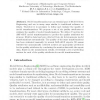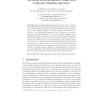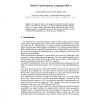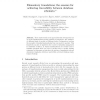EDOC
2004
IEEE
15 years 4 months ago
2004
IEEE
Modeling is a technique used extensively in industry to define software systems, the UML being the most prominent example. With the increased use of modeling techniques has come t...
132
click to vote
PAAMS
2009
Springer
15 years 5 months ago
2009
Springer
Abstract Many Multi-Agent Systems (MAS) methodologies incorporate a modeldriven approach. Model Driven Engineering is based on three main ideas: models are the “first-class citi...
126
Voted
MODELS
2009
Springer
15 years 5 months ago
2009
Springer
Triple graph grammars (TGGs) are a formal and intuitive concept for the specification of model transformations. Their main advantage is an automatic derivation of operational rule...
108
click to vote
ICWE
2009
Springer
15 years 5 months ago
2009
Springer
With the advent of the Web, search has become the prominent paradigm for information seeking, not only across the online space but also within enterprises. Search engine functiona...
88
Voted
ICMT
2009
Springer
15 years 5 months ago
2009
Springer
Model transformations are an essential part of Model Driven Engineering and are in many ways similar to traditional software artifacts. Therefore it is necessary to define and eva...
98
Voted
ICMT
2010
Springer
15 years 5 months ago
2010
Springer
Abstract. Model transformations play a key role in the vision of Modelngineering. Nevertheless, mechanisms like abstraction, variation and composition for specifying and applying r...
97
Voted
ICMT
2010
Springer
15 years 5 months ago
2010
Springer
Abstract. In Model-Driven Engineering (MDE), Higher-Order Transformations (HOTs) are model transformations that analyze, produce or manipulate other model transformations. In a pre...
95
Voted
MDAFA
2004
Springer
15 years 5 months ago
2004
Springer
Model transformations are the core of the MDA approach to software development. As specified by the OMG, model transformations should act on any kind of model of any kind of metamo...
87
Voted
MDAFA
2004
Springer
15 years 5 months ago
2004
Springer
The paper describes a new graphical model transformation language MOLA. The basic idea of MOLA is to merge traditional structured programming as a control structure with pattern-ba...
80
Voted
ER
2004
Springer
15 years 5 months ago
2004
Springer
There exist several recent approaches that leverages the use of model transformations during software development. The existence erent kinds of models, at different levels of abst...




